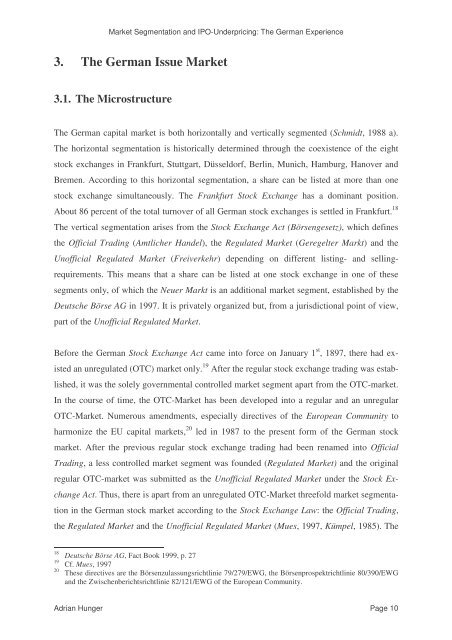Market Segmentation and IPO-Underpricing: The German Experience
Market Segmentation and IPO-Underpricing: The German Experience
Market Segmentation and IPO-Underpricing: The German Experience
Create successful ePaper yourself
Turn your PDF publications into a flip-book with our unique Google optimized e-Paper software.
<strong>Market</strong> <strong>Segmentation</strong> <strong>and</strong> <strong>IPO</strong>-<strong>Underpricing</strong>: <strong>The</strong> <strong>German</strong> <strong>Experience</strong><br />
3. <strong>The</strong> <strong>German</strong> Issue <strong>Market</strong><br />
3.1. <strong>The</strong> Microstructure<br />
<strong>The</strong> <strong>German</strong> capital market is both horizontally <strong>and</strong> vertically segmented (Schmidt, 1988 a).<br />
<strong>The</strong> horizontal segmentation is historically determined through the coexistence of the eight<br />
stock exchanges in Frankfurt, Stuttgart, Düsseldorf, Berlin, Munich, Hamburg, Hanover <strong>and</strong><br />
Bremen. According to this horizontal segmentation, a share can be listed at more than one<br />
stock exchange simultaneously. <strong>The</strong> Frankfurt Stock Exchange has a dominant position.<br />
About 86 percent of the total turnover of all <strong>German</strong> stock exchanges is settled in Frankfurt. 18<br />
<strong>The</strong> vertical segmentation arises from the Stock Exchange Act (Börsengesetz), which defines<br />
the Official Trading (Amtlicher H<strong>and</strong>el), the Regulated <strong>Market</strong> (Geregelter Markt) <strong>and</strong> the<br />
Unofficial Regulated <strong>Market</strong> (Freiverkehr) depending on different listing- <strong>and</strong> selling-<br />
requirements. This means that a share can be listed at one stock exchange in one of these<br />
segments only, of which the Neuer Markt is an additional market segment, established by the<br />
Deutsche Börse AG in 1997. It is privately organized but, from a jurisdictional point of view,<br />
part of the Unofficial Regulated <strong>Market</strong>.<br />
Before the <strong>German</strong> Stock Exchange Act came into force on January 1 st , 1897, there had ex-<br />
isted an unregulated (OTC) market only. 19 After the regular stock exchange trading was estab-<br />
lished, it was the solely governmental controlled market segment apart from the OTC-market.<br />
In the course of time, the OTC-<strong>Market</strong> has been developed into a regular <strong>and</strong> an unregular<br />
OTC-<strong>Market</strong>. Numerous amendments, especially directives of the European Community to<br />
harmonize the EU capital markets, 20 led in 1987 to the present form of the <strong>German</strong> stock<br />
market. After the previous regular stock exchange trading had been renamed into Official<br />
Trading, a less controlled market segment was founded (Regulated <strong>Market</strong>) <strong>and</strong> the original<br />
regular OTC-market was submitted as the Unofficial Regulated <strong>Market</strong> under the Stock Ex-<br />
change Act. Thus, there is apart from an unregulated OTC-<strong>Market</strong> threefold market segmenta-<br />
tion in the <strong>German</strong> stock market according to the Stock Exchange Law: the Official Trading,<br />
the Regulated <strong>Market</strong> <strong>and</strong> the Unofficial Regulated <strong>Market</strong> (Mues, 1997, Kümpel, 1985). <strong>The</strong><br />
18<br />
Deutsche Börse AG, Fact Book 1999, p. 27<br />
19<br />
Cf. Mues, 1997<br />
20<br />
<strong>The</strong>se directives are the Börsenzulassungsrichtlinie 79/279/EWG, the Börsenprospektrichtlinie 80/390/EWG<br />
<strong>and</strong> the Zwischenberichtsrichtlinie 82/121/EWG of the European Community.<br />
Adrian Hunger Page 10


